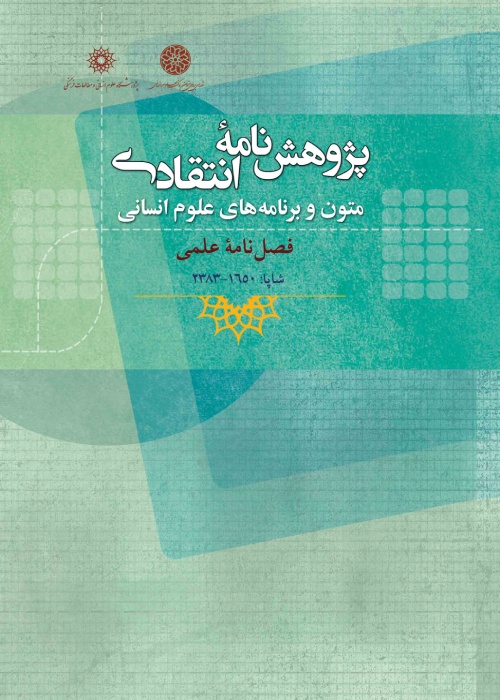A Research in Ibn Hesham Ansari Ideas Including Sentence-Like & Koran Samples
Author(s):
Abstract:
In Arabic Syntax، a ‘Sentence-like structure’ Phrase refers to a time or place adverbs، or noun complements. This concept and its form necessitates a brief look at concepts such as sentence، discourse، predication، combinations، composites، role of similitude in Arabic syntax. Since time and place adverbs، and noun complements are instances of combinations، and because they are made up of either two nouns، as in “end-dak”، or a noun and a proposition، as in ‘fed daar’; and since the propositional component as well as the adverbial component are not qualified to act as a subject or a predicate; and since they don’t bear any predication، but only a superficial similarity exists between their structure and a sentence; only similarity between them and a sentence is the link between their two components; and since they are not singular and they are similar to a sentence; and since there is no predication، therefore، they are not sentences. In other words، they are sentence-like structures. Moreover، because a phrase has no predication، it may accept a variety of features; it can be linked to whole or partial predicative combinations. As such as، it can have predication، and on this basis، it sometimes appears in the beginning، as in ‘Robba rajolen ghaem’، and sometimes as a predicate، as in ‘Zayd fed-daar’. Furthermore، since a sentence-like structure doesn’t bear any semantic and conceptual independence، it needs a word to provide meaning. Therefore، a need for the belonging، the belonged and the belonging-to is felt; and the stronger the belonged entity، more stable، more feasible، and more powerful the meaning will be. So، the first level of belonging and the best and highest aspect thereof is considered to be the belonging to a verb and verb-like form. However، experts in syntax believe that if the belonged is a common masculine، or a proper masculine or a released verb، then، the time or place adverb is an unlimited adverb; and if the belonged is a released common verb، the adverb is a limited adverb. When dealing with a limited adverb، the corresponding meaning bears an appropriate position and independence، it may be accessible through the concept of combination. In case of adverb، there is no semantic independence، therefore، it should be given meaning by considering the belonged and the belonging-to.
Keywords:
Language:
Persian
Published:
Critical Studies in Texts & Programs of Juman Sciences, Volume:12 Issue: 25, 2013
Pages:
19 to 36
magiran.com/p1132497
دانلود و مطالعه متن این مقاله با یکی از روشهای زیر امکان پذیر است:
اشتراک شخصی
با عضویت و پرداخت آنلاین حق اشتراک یکساله به مبلغ 1,390,000ريال میتوانید 70 عنوان مطلب دانلود کنید!
اشتراک سازمانی
به کتابخانه دانشگاه یا محل کار خود پیشنهاد کنید تا اشتراک سازمانی این پایگاه را برای دسترسی نامحدود همه کاربران به متن مطالب تهیه نمایند!
توجه!
- حق عضویت دریافتی صرف حمایت از نشریات عضو و نگهداری، تکمیل و توسعه مگیران میشود.
- پرداخت حق اشتراک و دانلود مقالات اجازه بازنشر آن در سایر رسانههای چاپی و دیجیتال را به کاربر نمیدهد.
دسترسی سراسری کاربران دانشگاه پیام نور!
اعضای هیئت علمی و دانشجویان دانشگاه پیام نور در سراسر کشور، در صورت ثبت نام با ایمیل دانشگاهی، تا پایان فروردین ماه 1403 به مقالات سایت دسترسی خواهند داشت!
In order to view content subscription is required
Personal subscription
Subscribe magiran.com for 70 € euros via PayPal and download 70 articles during a year.
Organization subscription
Please contact us to subscribe your university or library for unlimited access!


